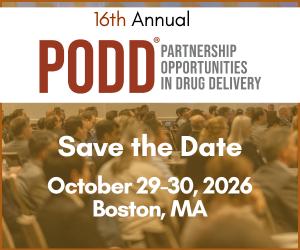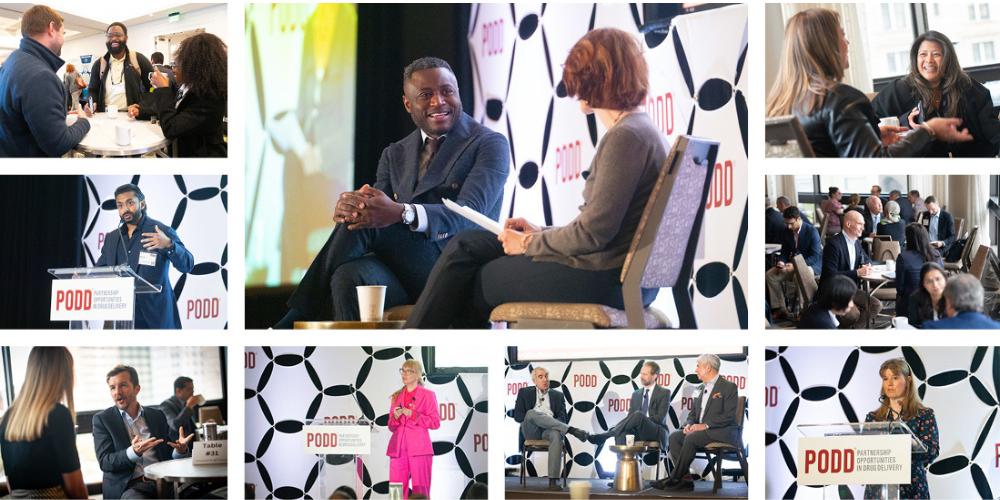PODD 2023: Combination Product Development Approaches with Pfizer, Genentech, AstraZeneca, Kymanox and Windgap Medical
Insights to key approaches to enable effective and efficient combination drug product development was one of the most well received sessions at PODD 2023. We bring you a summary of these insights from panelists Dr Josh Horvath, PhD, Genentech, Courtney Nicholas Sutton, AstraZeneca, Dr Stefanie Johns, PhD, Kymanox, and Jason Durkin, Windgap Medical. Amir Tabaian, Pfizer moderated the session.

From the outset, the group explained, investing in strategy early leads to fewer delays throughout development. This starts with educating your teams about the nuances of combination product development in order to set forth processes and documentation that avoid common mistakes.
Courtney Nicholas Sutton, AstraZeneca: For me, it boils down to two things. In addition to communication, at the end of the day, we're a pharma company. We want to get this drug to patients as soon as possible. We want to keep our clinical trials on track. We want our commercial launch to stay on track. We need the device in the combination product to enable that.
There's still a lot of education that has to go on to explain why a device is different than a drug and why we have a different development pathway we need to satisfy. That is a great challenge within multiple pharma companies. It’s a conversation we’re constantly having. There is not as much flexibility within combination product development as there is within a drug development program and so locking in those requirements as early as our device colleagues would like us to is really challenging and it’s a constant negotiation with the drug teams.
Stefanie Johns, Kymanox: Another challenge is educating regulators about your novel delivery products. For any delivery program, I’ve spent a lot of time trying to get the reviewers to understand the critical attributes of how the device performs and how it relates to the delivery of the drug. If they don’t understand that, they will give requirements that make no sense and that complicate your program. For example, I was working on a nasal spray product and in a type C meeting a reviewer literally asked me for the injection depth.Make sure you are communicating very clearly to regulators and push back if you get a response that doesn’t make sense. You have to advocate for your program. Just because you got bad or weird feedback from an agency it does not mean that it’s the end.
"From a platform perspective, it’s very challenging to develop a durable platform and to define a design space that will stand the test of time. It’s a great starting point but it is often just that; a starting point." - Courtney Nicholas Sutton, AstraZeneca
Amir Tabaian, Pfizer: Sometimes in pharma we think that developing a platform device allows us to do all of the initial work once. Why is this not the case?
Jason Durkin, Windgap Medical: If you have a marketing department, they’re always going to want you to change your platform from circle to square or blue to red to differentiate from a previous product. So while platform devices are talked about as being like off-the-shelf, they aren’t. You grab a device and your team will want to modify it to meet the needs of the drug and the brand and all of that takes time and could introduce variables you didn’t anticipate. Even when you introduce improvements, that always leads to some additional challenges. Regardless of the development program, there are unknowns that you will come across.
Courtney: From a platform perspective, it’s very challenging to develop a durable platform and to define a design space that will stand the test of time. It's easy to do it with the information we have today, but it seems that as soon as you draw a line in the sand of what your design space is, the next molecule inevitably falls outside of that design space. It’s a great starting point but it is often just that; a starting point.
Josh Horvath, Genentech: I've seen a shift over the past few years, where unless you have a real device platform that's launched multiple molecules, there is not a ton of appetite to take risks with a combination product for the initial launch. Even if you’re close to being on the critical path, teams want to get ready to launch with a vial and bring the combination product a couple of years later.
This doesn’t actually work, according to Mr Durkin, because there are always slight differences when you change the drug being used in the platform device. Those changes could even be from a marketing angle, to differentiate one brand of drug from another by changing the color or shape of the device. He continued that even when introducing improvements challenges usually arise.
"Having somebody with the visibility and expertise to see the bigger picture and how everything is coming together is paramount." - Stefanie Johns, Kymanox
Amir: When using platform devices, are you able to leverage data for regulatory submissions at all?
Stefanie: Absolutely. I recommend companies with platform devices to consider putting the bulk majority of information that’s not going to change into a master access file. It keeps your information proprietary and confidential. It makes it easier to maintain from a post market commercial perspective, because you can update one file rather than updating every single file. And then that amendment can then trigger an update to your NDA or BLA for the pharma partner. It’s much more manageable. It also makes it easier from a review perspective because all of the information is in one place.
When you're in the R&D period of development of your platform, really understand where your operation ranges and what happens when you go outside of that range. What is the level of failure? These are the things I actually use to negotiate with the agency when things do go wrong in clinical studies. This is how I get companies out of trouble when they have an unexplained failure or when something occurs that we know wouldn’t have a negative impact on the actual delivery of the drug. Really spend that time characterizing your range and what really happens when it does fail.
Amir: Is there a way to use platform devices to speed up combination product development?
Courtney: You need to define a good design space. But beyond that you need to understand what your edge of failure is so that you truly know if you can fit within that platform in the future. You might not have the time to do this the first time you use a platform device but in the time between programs you have a great opportunity to learn as much as you can about the process. It’s important to think about how you create options for future development and try to bridge that gap to make subsequent developments as straightforward as possible.
Josh: Think about how you create documentation. Maybe you don't go all the way towards a master access file, but if you're creating a bunch of documents that are doing mechanical testing on auto injector, a pump or a pre-filled syringe, and you're not even referencing the drug in the test, tell the engineers not to put the drug name all over the document because if they do you won’t be able to reuse it for something else. Even simple changes like that can save a lot of time in terms of preparing a documentation package if you think something might become a platform later. I learned that the hard way by having to redo about 300 documents a couple of years ago.
Jason: Another advantage with the platform device, especially if you have it licensed to multiple customers, is that you have multiple sets of eyes. You have a long span of time with multiple customers offering input and feedback, which you can use to modify your device to make it more efficient and effective.
"You can’t expect the folks at drug product development to have combination product development expertise. We are the ones who do it constantly so we need to educate people about how things work." - Josh Horvath, Genentech
Amir: How do we build a more knowledgeable culture within our organizations?
Courtney: Early engagement is key. There is an educational element to working with the therapeutic areas and the individual molecule programs. It’s very common for different teams to have questions about what is involved in combination product development. We are there to help guide teams along the way. You want to know what the formulation is going to look like and what kind of device it could go into, whether it is a concentration and viscosity we can deal with, and whether the route of administration makes sense for the devices out there. Having the conversations early can help put the program in the most successful spot later on.
Jason: You need to have a good understanding and appreciate the duration and effort it takes to get a device to the market. If you lay out a business plan and it doesn’t account for the the twelve months it takes to get a piece of of automation in place to assemble your device and the nine months to get some tools and the three months to get a contract in place, you will lose time quickly and you business model will be less attractive.
Stefanie: As things are going along, have someone who is able to see that bigger picture and the end goal. Often, the individual project teams are so deeply focused on what they are doing, that even if they are able to communicate effectively, they aren’t necessarily able to see how the big pieces fit together. Having somebody with the visibility and expertise to see the bigger picture and how everything is coming together is paramount.
Amir: Any parting words of advice?
Jason: To increase your success, actively manage your partner. Don’t just write your partner a check and tell them to call you when they’ve developed your IP and brought it to market. Actively manage them and have a good, solid device team with oversight.
Courtney: Having regular touch points and being able to be creative, collaborative and flexible is the best way to ensure our mutual success.
Stefanie: If you do run into issues in studies, don’t hide it and submit it to the FDA. Have a meeting and discuss it with the agency with appropriate data and rationale. If you submit it and try to hide it you will get a CRL.
Josh: You can’t expect the folks at drug product development to have combination product development expertise. We are the ones who do it constantly so we need to educate people about how things work.
In This Article












